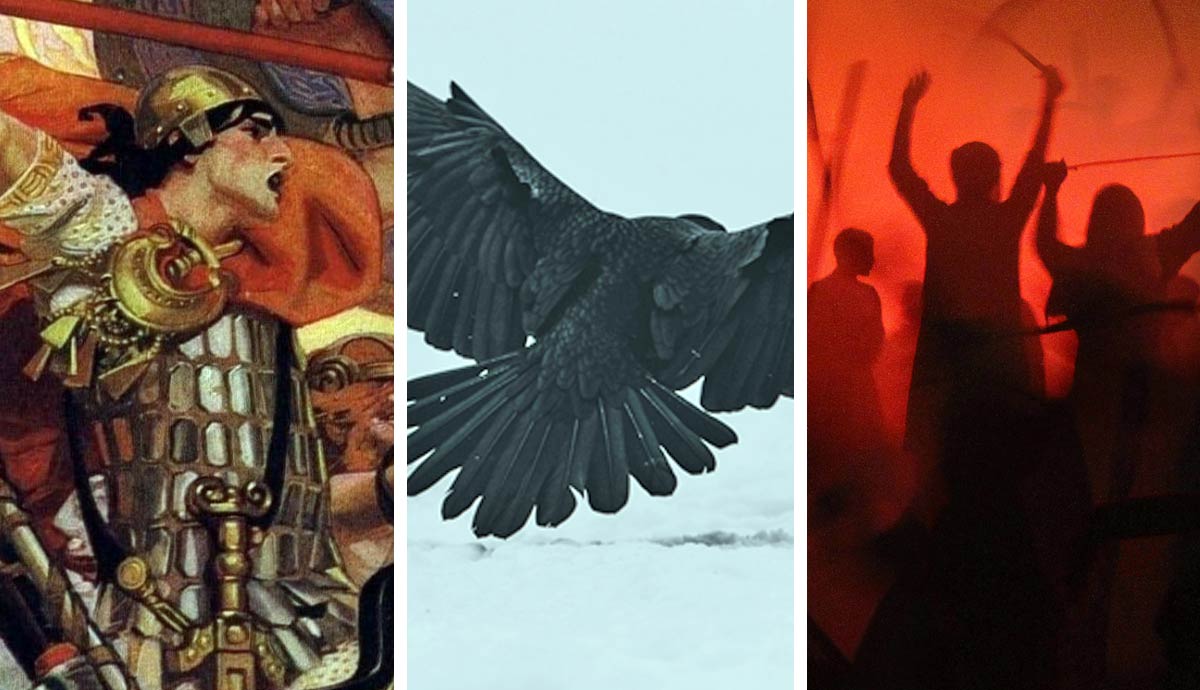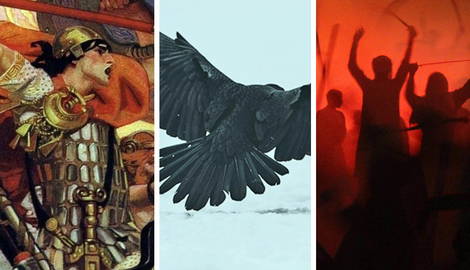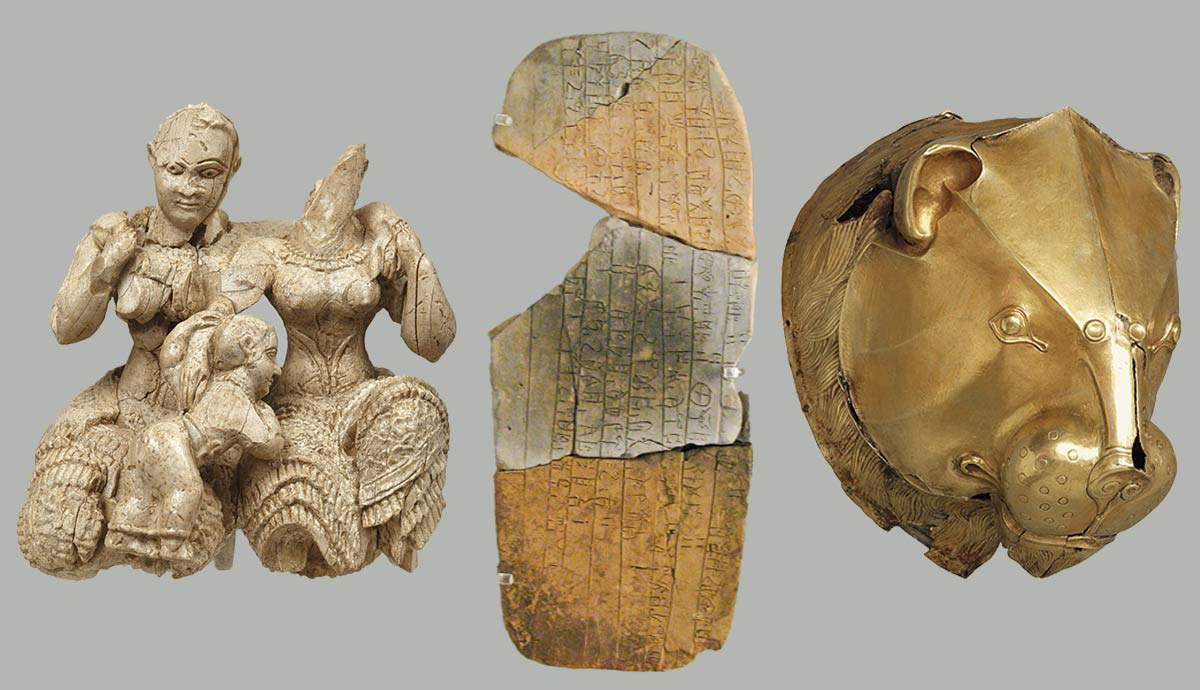
The most powerful goddess among the Tuatha dé Danaan, the Morrigan is a complex and often misunderstood figure from Irish myth. One woman or several, bearing either a name or a title (the meaning of which itself is disputed), the Morrigan’s identity is fluid and her domain is vast. Ruling over war and bloodshed, inciting and feeding off the chaos and frenzy of battle, yet standing as guardian and protector of the Tuath (the community and the land), and gatekeeper of kingship, the Morrigan’s authority spans life, death, and mortal power.
Great Queen or Nightmare Queen?

As with many older forms of European languages, Old Irish texts have a somewhat erratic approach to spelling and it is this lack of consistency that has led to debate around what the name/title “the Morrigan” actually means. A compound word in Old Irish, Morrigan can be broken into two parts: either the word mor or mór, depending on the manuscript, followed by the word rigan. Rigan means queen, but whether or not there is an accent, called a fada, over the “o” in mor completely changes the meaning of that part of the word.
If the correct spelling is mór, meaning great, then the name/title translates as Great Queen. If however, the correct spelling is mor, then it may be a word derived from the Proto-Indo-European word morā, meaning nightmare, or mṛwos, meaning dead. From there certain scholars have argued that Morrigan means Nightmare Queen, Phantom Queen, and even Queen of the Dead. However as the individual word mor appears nowhere in surviving Old Irish texts, and the modern Irish words for nightmare, tromluí, and dead, marbh, are very different, the idea that the word mor even existed within the Old Irish lexicon is speculation at best. The majority of scholars subscribe to the Great Queen theory as the proper translation.
Is “The Morrigan” a Name or a Title?

Though “the Morrigan” is popularly imagined as an individual goddess whose personal name is actually “Morrigan,” minus the definite article, this couldn’t be further from the truth. The first clue that the Morrigan is a title rather than a name comes from the fact that it is always preceded by the definite article.
This isn’t unique among Irish gods, others have similar title names, such as “the Dagda,” king of the Tuatha dé Danaan, whose name/title means “the Good God,” and Boand, “the White Cow,” a goddess of cattle and poetry connected to the Boyne river. While some title names are unique to individual gods, others like Beldergh, “Red-mouthed,” are used by multiple divinities with personal names of their own, and it is that latter category that The Morrigan falls into.
Multiple figures, sometimes in groups of three (plural Morrigna), are referred to as “the Morrigan” across Old Irish texts. When an individual goddess is referred to as The Morrigan those texts often specify her personal name as well. It seems clear that the Morrigan is a title, perhaps reflecting her status as the wife of the Dagda, her role as kingmaker, or—especially when pluralized—simply the sheer personal power the goddesses wielded.
Who Are the Morrigna?

The Morrigan is a title applied to a triad of goddesses and a handful of individuals across Old Irish source texts. The Book of Leinster version of the Lebor Gabala Erenn (The Book of Invasions) states that the Morrigan’s name is Anand/Danand, sister of (among others) Badb and Macha, while The Book of Fermoy version switches the title to Macha instead. The Sanas Cormac (Cormac’s Glossary) refers to the sisters as “the three Morrigans” while the Banschenchas (Lore of Women) list all three women alongside another otherwise unnamed Morrigu as among the “sorceresses of the Tuatha dé Danaan.”
The Metrical Dinshenchas (Lore of Places), Táin Bó Cúailnge (The Cattle Raid of Cooley), and both the First and Second Cath Maige Tuired (The Battle of Moytura) on the other hand refer to the Morrigan only by her title, leaving it in question which of the Morrigna is being referred to. This pattern occurs across other source texts, leaving us with a list of Morrigna that is three to five entries long: Anand/Danand (who may or may not be separate figures), Macha, Badb, and potentially another, otherwise unnamed entity only ever referred to as Morrigu.
Modern texts often include Nemain and Fea among the Morrigna and there is a popular belief that one or both form part of a second Morrigna triad with Babd and/or Macha. This appears to be a 19th-century idea however, possibly derived from the occasional conflation of Nemain with Badb in certain manuscripts, and the role of Fea and Nemain as war goddesses, as no primary sources refer to either goddess using the title.
A Triple Goddess? Yes, But Not Like That.

Thanks to Robert Graves’s The White Goddess the concept of the triple goddess as maiden, mother, and crone has made its way into the public consciousness as a universal archetype that all “triple goddesses” conform to. While the Morrigan can be viewed through the lens of the triple goddess, like most actual mythological triple goddesses she does not fit the Gravian archetype at all.
Several of the Morrigna have children but they are not goddesses of motherhood, rather they are goddesses who happen to be mothers, in the same way that the healer god Dian Cecht isn’t a father god simply by merit of his having had children (one of whom he murders out of jealousy). There is a tendency among both modern pagans and academics from a monotheistic background to assign mother goddess status to all female divinities who have children, regardless of their actual divine role, while male divinities with children do not receive the same treatment. This likely derives from preconceptions about identity, gender, and parenthood, but it’s important to remember that precisely because gods aren’t human their worshippers do not conceptualize them and their identities in the same way they would a human being.
Similarly, while the Morrigna do take on the form of both young women and crones in various texts these are not divine roles but rather disguises, put on to test various hero figures and potential kings, before being thrown off to reveal their ageless selves. They are not stable identities held by any of the Morrigna, their personal power and autonomy are not derived from perpetual virginity or elder status, and they do not act as patrons or protectors of those classes of women.
Goddess(es) of War

During The Ulster Cycle, we see all of the Morrigna inciting and interfering in the skirmishes and conflicts between Ulster and Connaught. The Morrigan (no personal name specified but likely Anand/Danand) sets up the events that will lead to the central conflict, as well as personally engaging in both physical and verbal conflict with the hero Cú Chulainn.
She and Badb incite their chosen warriors to greater ferocity, as well as prophesying or selecting who among them will live and who will die, while Badb also induces terror and battlefield madness. Macha, during one of her deaths (of which there are many), curses the men of Ulster to experience the pain of childbirth in their time of greatest need, striking them down mid-battle at a pivotal moment. We see here that they hold power over both individual warriors and their fates, inspiring or hobbling them in battle, and affecting the broader outcome of warfare itself.
The Morrigna are equally involved in divine warfare, providing tactical advice and engaging in both physical and magical combat when the Tuatha de Danaan make war on their divine cousins, the Fir Bolg, further reinforcing their role as goddesses of war.
Goddesses of Magic

In addition to Macha’s curses, and the Banschenchas labeling them all sorceresses, we see the Morrigna’s magic come into play during both Cath Maige Tuired. In the first, Badb, Macha, and an unnamed Morrigan (probably Danand/Anand) use magic to attack the Fir Bolg in battle, manifesting rains of fire and blood, and conjuring mists, and other hostile physical phenomena. In the second Cath Maige Tuired, the Morrigan and Badb both engage in prophecy about the battle’s outcome and Ireland’s future, and it is unclear if the Morrigan is engaging in magical or physical combat or both when she attacks the Fir Bolg king.
We don’t have enough information to determine whether this means the Morrigna, together or individually, were seen as goddesses of witchcraft or if their use of magic was part of their role as war goddesses. However, the traditional usage of bhaidhbh—a modern Irish spelling of Badb—as a synonym for witch implies a significant connection between human witches and at least one of the Morrigna with a lasting effect on folk culture post-Christianization.
Sovereignty Goddesses

Like many other Indo-European cultures, pre-Christian Ireland had a tradition of sovereignty goddesses: deities that represented the land, ensuring the safety and fertility of its people, crops, and animals, and acting as gatekeepers of kingship. To become king a royal candidate one would have to convince the goddess he had the right to rule—which is the literal meaning of the Irish word that is usually translated as “sovereignty”—at which point they would symbolically marry. Should the king go on to behave in a way that would disqualify him from rulership, said goddess would then abandon him, removing him from the throne.
As the wife of the Dagda and Great Queen of the Tuatha dé Danaan, the Morrigan is the prototypical sovereignty goddess. By providing him strategic advice before the battle with the Fir Bolg in the second Cath Maige Tuired, promising her martial support, and then having sex with him she is affirming his position as rightful king of their people, both by reaffirming their marital union and ensuring his victory in the coming battle.
Some scholars consider Medb Lethdergh, the sovereignty goddess of the Hill of Teamhair who chose and symbolically married the High King, and her human counterpart Queen Medb of Connaught, to have been manifestations of one or more Morrigna; performing the same role for the multiple human kings as the Morrigna Anand does for the Dagda and Tuatha dé Danaan.

We also see the Morrigan engaging in typical sovereignty goddess behaviors with Cú Chulainn during the Táin Bó Cúailnge: appearing to him as both a seductive young woman, proclaiming herself a king’s daughter, and offering herself in marriage, and as an old crone. Though some interpret this as the Morrigan being in love with Cú Chulainn it follows the pattern of a sovereignty goddess testing a candidate for kingship, with Cú Chulainn’s rejection of her in favor of the path of a warrior demonstrating that he was unfit for the role, ensuring his own death in the process.
As is common for horse goddesses the Morrigna Macha also appears to be a sovereignty goddess, most especially in her incarnation as Macha Mong Ruad, included in the king list as the 76th ruler of Ireland. Daughter of a king who shared the rulership of Ireland with two others, she took the throne by force when his co-kings refused to share with her after his death.
After the death of one of those kings his five sons then challenged her rule, so she went to each one disguised as a leper or a crone, seducing then binding them, forcing them to submit to her, before finally marrying the last surviving king and making him her consort. We see here how she tests each candidate for the kingship of Ireland, with those who fail her test (being seduced and then bound by her) unable to rule, with the last marrying her and getting to rule at her side.

Unlike the other Morrigna, Babd does not appear to function as a sovereignty goddess, though whether this is due to the incomplete nature of our sources, with tales depicting her as such now lost to time, or some fundamental difference between her and her sisters, is unclear. She does appear to have a more specialized role than the other Morrigna in the surviving sources, with a focus on the chaotic, ungovernable aspects of warfare, and it may be that this chaotic nature is what sets her apart from kingship, conceived of as the root of civilization and order in early Irish society.








